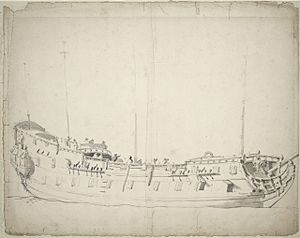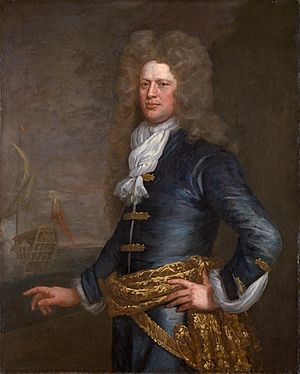HMS Adventure (1646) facts for kids

Portrait of the Adventure as a 40-gun fourth-rate, drawn by Willem van de Velde the Elder
|
|
Quick facts for kids History |
|
|---|---|
| Name | Adventure |
| Ordered | December 1645 |
| Builder | Woolwich Dockyard |
| Launched | 1646 |
| Commissioned | 1646 |
| Honours and awards |
|
| Captured | By the French on 1 March 1709 |
| General characteristics | |
| Class and type | 34-gun Fourth-Rate |
| Tons burthen | 385+3⁄94 bm |
| Length | 94 ft (29 m) keel for tonnage |
| Beam | 27 ft 9 in (8.5 m) |
| Draught | 13 ft 9 in (4.2 m) |
| Depth of hold | 13 ft (4 m) |
| Sail plan | ship-rigged |
| Armament |
|
| General characteristics after 1691 rebuild | |
| Class and type | 44-gun fourth-rate ship |
| Tons burthen | 438+91⁄94 bm |
| Length |
|
| Beam | 29 ft 0 in (8.8 m) |
| Depth of hold | 12 ft (4 m) |
| Sail plan | ship-rigged |
| Armament |
|
HMS Adventure was a powerful warship of the English Navy. It was built in 1646 at Woolwich Dockyard. This ship was known as a "fourth-rate" vessel, meaning it carried a good number of guns.
Adventure played a big role in many important events. It served during the English Civil War and later joined the Commonwealth Navy. After the monarchy was restored, it became part of the Royal Navy. The ship fought in several major battles and captured enemy vessels. Sadly, it was captured by the French in 1709.
Contents
Building the Adventure
The order to build Adventure was given in December 1645. It was constructed at Woolwich Dockyard by a skilled shipbuilder named Peter Pett II. The ship was ready and launched in 1646.
When first built, Adventure was about 94 feet long. It was designed to be a strong warship. Over time, the number and types of guns it carried changed.
Ship's Guns and Power
- In 1666, Adventure had 38 guns. These included large cannons called culverins and smaller ones like demi-culverins and sakers.
- By 1677, it could carry up to 44 guns during wartime.
- In 1685, the ship had 40 guns, including different sizes of cannons.
Building the Adventure cost about £2,618, which was a lot of money back then!
Adventure's Time at Sea
Adventure had a long and busy career, serving in different periods of English history.
Serving During the English Civil War
Adventure began its service in 1646. It was commanded by Captain Thomas Beddall. The ship patrolled the coasts during winter and spring. In 1648, under Captain Andrew Ball, it helped blockade Kinsale in Ireland. It also sailed near the Isles of Scilly in 1649.
In 1650, Adventure joined the Commonwealth Navy. It sailed with Robert Blake's fleet. The ship fought in several key battles:
- The Battle off Dover in May 1652.
- The Battle of Portland in February 1653. This victory helped England control the English Channel.
- The Battle of Gabbard in June 1653.
- The Battle of Scheveningen in July 1653.
After these battles, Adventure was used for important missions, like an embassy to Sweden.
After the Monarchy Was Restored
In 1661, Adventure became part of the Royal Navy. It sailed to Tangier in 1662. The ship continued to fight in major conflicts:
- The Battle of Lowestoft in 1665.
- The Battle of Oxfordness in 1666.
- It captured a French ship called Le Rubis in 1666.
- The Battle of Solebay in 1673.
Adventure also had success capturing enemy ships in the 1680s. It destroyed the 32-gun Citron Tree and captured the 28-gun Calibash. It also took the 46-gun Golden Horse.
Rebuilt and Ready for More Action
In 1690, Adventure was ordered to be rebuilt at Chatham Dockyard. This was a major upgrade! The ship was relaunched in 1691.
After the rebuild, Adventure was even larger and more powerful. It was now about 117 feet long. Its armament was also updated:
- It carried 9-pounder guns on the lower deck.
- It had 6-pounder guns on the upper deck.
- Smaller 3-pounder guns were on the quarterdeck, later replaced by 4-pounders.
The rebuild cost a lot, showing how important Adventure was to the navy.
Adventure's Later Service
After its rebuild, Adventure was commanded by Captain Thomas Dilkes. It took part in the Battle of Barfleur in 1692, a huge naval battle.
The ship continued to be very active:
- It captured two enemy privateer ships in Ireland in 1692.
- It captured two more privateers in the English Channel.
- In 1694, it helped capture a 36-gun French ship called La Diligente.
- In 1695, it captured two large French ships, Le Content and Le Trident.
Adventure served in the Mediterranean and the North Sea. In 1703, it was commanded by Captain John Balchen. It also captured the 24-gun French ship Le Jeux in 1706.
The End of Adventure's Journey
Adventure was eventually captured by a French squadron. This happened off Montserrat, Martinique in the West Indies on March 1, 1709. About 100 of its crew, including Captain Clark, were lost or injured during the capture.


